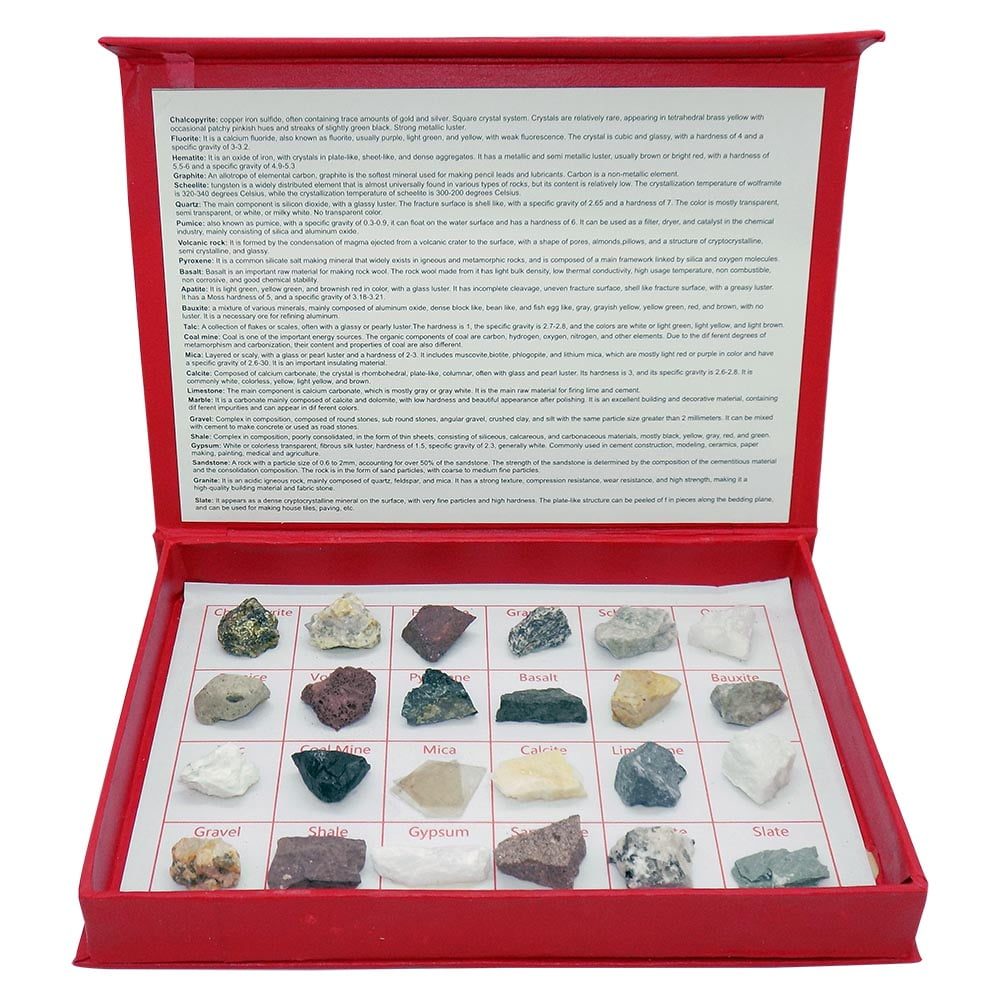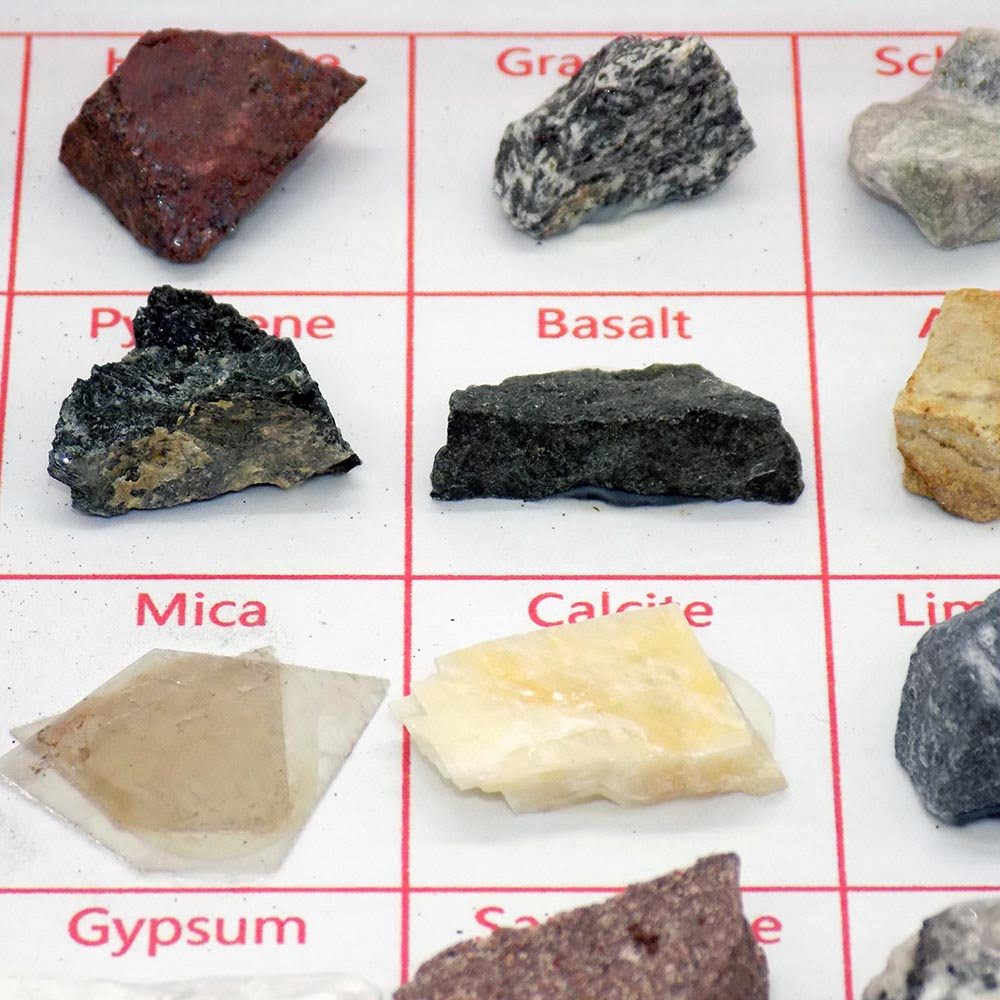It is a mineral set used to show examples of rocks and minerals found in nature.
Mineral Collection Content
- Chalcopyrite
- Fluorite
- Hematite
- Graphite
- Scheelite
- Quartz
- Pumice
- Volcanics
- Pyroxene
- Basalt
- Apatite
- Bauxite
- Talc
- Coal Mine
- Mica
- Calcite
- Limestone
- Marble
- Gravel
- Shale
- Gypsum
- Sandstone
- Granite
- Slate
Mineral Set Features
- Box Dimensions: 19.5×13.5×3 cm
- Mine Dimensions: ~2×2 cm
- Total Weight: 192 gr
Descriptions of Minerals and Rocks
Chalcopyrite: copper iron sulfide, often containing trace amounts of gold and silver. Square crystal system. Crystals are relatively rare, appearing in tetrahedral brass yellow with occasional patchy pinkish hues and streaks of slightly green black. Strong metallic luster.
Fluorite: It is a calcium fluoride, also known as fluorite, usually purple, light green, and yellow, with weak fluorescence. The crystal is cubic and glassy, with a hardness of 4 and a specific gravity of 3-3.2.
Hematite: It is an oxide of iron, with crystals in plate-like, sheet-like, and dense aggregates. It has a metallic and semi metallic luster, usually brown or bright red, with a hardness of 5.5-6 and a specific gravity of 4.9-5.3.
Graphite: An allotrope of elemental carbon, graphite is the softest mineral used for making pencil leads and lubricants. Carbon is a non-metallic element.
Scheelite: tungsten is a widely distributed element that is almost universally found in various types of rocks, but its content is relatively low. The crystallization temperature of wolframite is 320-340 degrees Celsius, while the crystallization temperature of scheelite is 300-200 degrees Celsius.
Quartz: The main component is silicon dioxide, with a glassy luster. The fracture surface is shell like, with a specific gravity of 2.65 and a hardness of 7. The color is mostly transparent, semi transparent, or white, or milky white. No transparent color.
Pumice: Also known as pumice, with a specific gravity of 0.3-0.9, it can float on the water surface and has a hardness of 6. It can be used as a filter, dryer, and catalyst in the chemical industry, mainly consisting of silica and aluminum oxide.
Volcanic rock: It is formed by the condensation of magma ejected from a volcanic crater to the surface, with a shape of pores, almonds, pillows, and a structure of cryptocrystalline, semi crystalline, and glassy.
Pyroxene: It is a common silicate salt making mineral that widely exists in igneous and metamorphic rocks, and is composed of a main framework linked by silica and oxygen molecules.
Basalt: Basalt is an important raw material for making rock wool. The rock wool made from it has light bulk density, low thermal conductivity, high usage temperature, non combustible, non corrosive, and good chemical stability.
Apatite: It is light green, yellow green, and brownish red in color, with a glass luster. It has incomplete cleavage, uneven fracture surface, shell like fracture surface, with a greasy luster. It has a Moss hardness of 5, and a specific gravity of 3.18-3.21.
Bauxite: A mixture of various minerals, mainly composed of aluminum oxide, dense block like, bean like, and fish egg like, gray, grayish yellow, yellow green, red, and brown, with no luster. It is a necessary ore for refining aluminum.
Talc: A collection of flakes or scales, often with a glassy or pearly luster. The hardness is 1, the specific gravity is 2.7-2.8, and the colors are white or light green, light yellow, and light brown.
Coal mine: Coal is one of the important energy sources. The organic components of coal are carbon, hydrogen, oxygen, nitrogen, and other elements. Due to the different degrees of metamorphism and carbonization, their content and properties of coal are also different.
Mica: Layered or scaly, with a glass or pearl luster and a hardness of 2-3. It includes muscovite, biotite, phlogopite, and lithium mica, which are mostly light red or purple in color and have a specific gravity of 2.6-30. It is an important insulating material.
Calcite: Composed of calcium carbonate, the crystal is rhombohedral, plate-like, columnar, often with glass and pearl luster. Its hardness is 3, and its specific gravity is 2.6-2.8. It is commonly white, colorless, yellow, light yellow, and brown.
Limestone: The main component is calcium carbonate, which is mostly gray or gray white. It is the main raw material for firing lime and cement.
Marble: It is a carbonate mainly composed of calcite and dolomite, with low hardness and beautiful appearance after polishing. It is an excellent building and decorative material, containing dif ferent impurities and can appear in different colors.
Gravel: Complex in composition, composed of round stones, sub round stones, angular gravel, crushed clay, and silt with the same particle size greater than 2 millimeters. It can be mixed with cement to make concrete or used as road stones.
Shale: Complex in composition, poorly consolidated, in the form of thin sheets, consisting of siliceous, calcareous, and carbonaceous materials, mostly black, yellow, gray, red, and green.
Gypsum: White or colorless transparent, fibrous silk luster, hardness of 1.5, specific gravity of 2.3, generally white. Commonly used in cement construction, modeling, ceramics, paper making, painting, medical and agriculture.
Sandstone: A rock with a particle size of 0.6 to 2mm, accounting for over 50% of the sandstone. The strength of the sandstone is determined by the composition of the cementitious materia and the consolidation composition. The rock is in the form of sand particles, with coarse to medium fine particles.
Granite: It is an acidic igneous rock, mainly composed of quartz, feldspar, and mica. It has a strong texture, compression resistance, wear resistance, and high strength, making it a high-quality building material and fabric stone.
Slate: It appears as a dense cryptocrystalline mineral on the surface, with very fine particles and high hardness. The plate-like structure can be peeled of fine pieces along the bedding plane, and can be used for making house tiles, paving, etc.





















































































